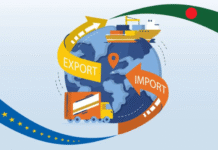The country’s trade gap with India in the first nine months of the current financial year continued to hover at $4.06 billion despite a slight increase in exports to the neighbouring country.
The trade gap was still high as different non-tariff barriers continued to limit Bangladesh’s exports to the neighbouring country, said economists and experts.
Bangladesh’s imports from India stood at $4.45 billion in July-March of the FY 2014-2015 whereas exports stood at $396.43 million during the period.
The trade gap in July-March in the FY14 was $4.17 billion with an export figure of $284.49 million and import of $4.45 billion.
A BB official told New Age on Sunday that the trade gap with India decreased in the first nine months of the FY15 as the country’s export earnings from the neighbouring country slightly increased while import remained static.
‘The businesspeople has recently adopted a “wait and see” approach to their business expansion by opening letters of credit for import due to political unrest. For this reason, the imports from India remained static in the first three quarters of the FY15,’ he said.
He said that the increased export to India in the first nine months of the FY15 was not satisfactory as Bangladesh posted a paltry export figure of $396.43 million in July-March period of the FY15. The export figure was $284.49 million during the same period of the FY14.
Policy Research Institute of Bangladesh executive director Ahsan H Mansur told New Age on Sunday that the country had been facing a large trade gap with China and India for a long time due to lower export earnings against higher import payments.
The government should give pressure to India on political ground so that the country’s businesspeople would be able to increase their export items, he said.
Mansur said the commerce ministry should take initiative to avoid non-tariff barriers with India that would help the exporters to increase their items to the neighbouring country.
The government also should take initiative to strengthen Bangladesh Standards and Testing Institution so that the organisation will be able to conduct proper testing of the export products, he said.
The foreign countries will get more confidence to import products from Bangladesh if the products will be tested accurately, Mansur said.
Former finance adviser to interim government AB Mirza Azizul Islam told New
Age earlier that the trade deficit of Bangladesh against India was still high as different non-tariff barriers continued to limit Bangladesh’s exports to the neighbouring country.
The businesspeople have long been raising their concern in this connection but the India’s government is yet to mitigate the problem, he said.
Mirza Aziz said the Bangladesh government should take step to continue discussion with New Delhi with a view to removing the non-tariff barrier.
Besides, the country’s industrial sector has also facing a production crisis due to the recent political unrest and that might have played a role in the large trade deficit between the two countries, he said.
‘It is a natural phenomenon that Bangladesh usually faces a deficit with the neighbouring country considering the volume of India’s economy. But, the size of the deficit it has been maintaining for years is not acceptable,’ Aziz said.
Source: New Age










